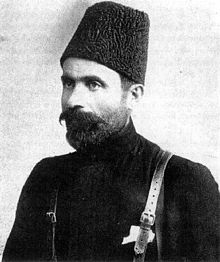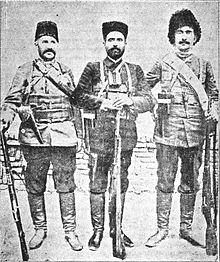This is the current revision of this page, as edited by Hay kamavor (talk | contribs) at 06:00, 12 December 2024 (add references). The present address (URL) is a permanent link to this version.
Revision as of 06:00, 12 December 2024 by Hay kamavor (talk | contribs) (add references)(diff) ← Previous revision | Latest revision (diff) | Newer revision → (diff) Armenian revolutionary (1868–1912)| This article needs additional citations for verification. Please help improve this article by adding citations to reliable sources. Unsourced material may be challenged and removed. Find sources: "Yeprem Khan" – news · newspapers · books · scholar · JSTOR (April 2024) (Learn how and when to remove this message) |
| Yeprem Khan | |
|---|---|
 | |
| Birth name | Yeprem Davidian |
| Nickname(s) | Khan |
| Born | 1868 Barsum, Elisabethpol Governorate, Russian Empire |
| Died | 18 May 1912(1912-05-18) (aged 43–44) Shurcheh, Kermanshah, Iran |
| Buried | Holy Mother of God Church, Tehran |
| Allegiance | |
| Years of service | 1896–1912 |
| Battles / wars | Armenian National Liberation Movement Persian Constitutional Revolution |
Yeprem Khan (Armenian: Եփրեմ Խան; 1868–1912), born Yeprem Davidyan (Armenian: Եփրեմ Դավթյան, Persian: یپرمخان داویدیان), was an Iranian-Armenian member of the Armenian Revolutionary Federation (ARF), revolutionary leader and a leading figure in the Constitutional Revolution of Iran.
He is considered a national hero in Iran.
Life
Early life

Yeprem Khan was born to an Armenian family in the village of Barsum (Armenian: Բարսում), located in Elisabethpol Governorate of the Russian Empire (located in present-day Azerbaijan).
In his youth, Yeprem participated in Armenian nationalist groups as well as in partisan activities against the Ottoman Empire. In September 1890, Yeprem was arrested by the Russian Cossacks. He was exiled to Siberia by 1892, from where he managed to escape to Tabriz in 1896. While in Tabriz, he began working for the Armenian Revolutionary Federation (ARF Dashnaktsutyun), whose activity in Persia was primarily directed against the Ottoman Empire, and established its local branches in Tabriz, Urmia and Rasht.
Revolutionary

Yeprem was highly instrumental in the Iranian Constitutional Revolution, and, by 1907, convinced ARF to actively participate in it. After the Persian national parliament was shelled by the Russian Colonel Vladimir Liakhov, Yeprem Khan united with Sattar Khan and other revolutionary leaders in the Constitutional Revolution of Iran against Mohammad Ali Shah Qajar.
In October 1908, during Tabriz resistance, Yeprem Khan formed a secret Sattar Committee (in honor of Sattar Khan) in Rasht, and established contacts with Social Democrats, Social Revolutionaries, and the ARF in the Caucasus. Reinforced by 35 Georgians and twenty Armenians from Baku, Yeprem captured Rasht and then planted his red flag on the town hall of Anzali. Further reinforced by Mohammad Vali Sepahdar, the main landed magnate of the Caspian provinces and former Qajar commander, Yeprem Khan marched his forces of Caucasian guerillas and Mazandarani peasants towards Tehran, which he entered in July 1909. After the capture of Tehran, Mohammad Ali Shah Qajar fled from his palace to the Russian Embassy. On the same day, the Iranian Parliament set in an extraordinary meeting to replace Mohammad Ali Shah Qajar in favor of his son Ahmad Shah Qajar. On 10 September 1909, Mohammad Ali Shah Qajar left the Russian Embassy and went into exile in Odessa in Russia (today part of Ukraine).
Police chief in Iran
On 30 July 1909, the Second National Assembly (Parliament) of Iran, appointed Yeprem Khan as the police chief of Tehran. After becoming the police chief of Tehran, he restored order in the city and made various reforms to the police force. In 1910, he became chief police of all Iran. He further split from revolutionaries, when in 1910, Sattar Khan, a hero of the civil war, refused to obey the government order to disarm. After a brief but violent confrontation at Atabek Park in Tehran, Yeprem Khan, using Shah's army and police forces, disarmed Sattar Khan. In 1911 Mohammad Ali Shah Qajar plotted his return to power from Odessa. He later landed at Astarabad, Iran, but his forces were defeated by Yeprem. Mohammad Ali Shah then fled to Russia, then in 1920 to Constantinople and later to San Remo, Italy, where he died five years later in April 1925 (he was buried in Karbala, Iraq).
Yeprem Khan was killed on 19 May 1912 while he was trying to rescue one of his comrades in a battle in Shurcheh in Kermanshahan Province. He was killed by some of Mohammad Ali Shah Qajar's loyal troops who remained in Iran. Arshak Gavafian (Keri) later killed the murderers of Yeprem Khan in revenge.
He is buried in St. Mary Church in downtown Tehran.
Legacy

Yeprem Khan is today, along with many important figures like Sattar Khan, considered a national hero of Iran. He is also praised by Iranian historians such as Ahmad Kasravi and by Morgan Shuster, treasurer-general of Persia in that time. There exists a popular Armenian patriotic song dedicated to the memory and deeds of Yeprem Khan. The Iranian sculptor Lilit Teryan has created a sculpture of Khan. The statue is at St Mary's church in Tehran.
References
- Chamanara, Sohrab (2015-03-16). 2020: THE FALL OF ISLAMIC STATES & THE RRISE OF A NEW POLITICAL ORDER. Ketab.com. ISBN 978-1-59584-500-9.
- Hosseini, S. Behnaz (2023-07-19). Religious Minorities' Migration from Iran: A Human Rights Perspective. Cambridge Scholars Publishing. ISBN 978-1-5275-1068-5.
- ^ "Aram Arkun. "Eprem Khan", Encyclopedia Iranica, Online Edition". Archived from the original on 2019-04-27. Retrieved 2012-09-03.
- Yarshater, Ehsan (1998). Encyclopaedia Iranica: Ebn ʻAyyāš. Mazda Publishers. ISBN 978-1-56859-057-8.
- The Oriental World. Vol. 3–7. Oriental World Publishing Company. 1906.
- "Aram Arkun. "Dashnak (Armenian Revolutionary Federation)", Encyclopedia Iranica, Online Edition". Archived from the original on 2023-08-15. Retrieved 2012-09-03.
- Berberian, Houri (1996). "The Dashnaktsutiun and the Iranian Constitutional Revolution, 1905-1911". Iranian Studies. 29 (1/2): 7–33. ISSN 0021-0862.
- ^ Houri Berberian. Armenians and the Iranian Constitutional Revolution, 1905–1911, Westview Press, 2001, ISBN 0-8133-3817-4, p. 132
- Yeprem Khan. "Memoirs", Ittila'at-i Mahaneh, 2 (July 1948), p. 19-21
- Elton L. Daniel. The History of Iran, Greenwood Press, 2000, ISBN 0-313-30731-8, p. 312
- ^ Ervand Abrahamian. Iran between two revolutions, Princeton University Press, 1982, ISBN 0-691-10134-5, p. 99
- Ervand Abrahamian. Khomeinism: Essays on the Islamic Republic, I.B. Tauris, 1993, ISBN 1-85043-779-3, p. 93
- Donzel, Emeri "van" (1994). Islamic Desk Reference. ISBN 90-04-09738-4. p. 285-286
- Yaghoubian, David N. (2014-07-08). Ethnicity, Identity, and the Development of Nationalism in Iran. Syracuse University Press. ISBN 978-0-8156-5272-4.
- Barry, James (2019). Armenian Christians in Iran: Ethnicity, Religion, and Identity in the Islamic Republic. Cambridge University Press. ISBN 978-1-108-42904-7.
- Morgan Shuster, The Strangling of Persia. New York 1912.
- "لیلیت تریان از پیشتازان مجسمهسازی در ایران درگذشت". 2019-03-08. Archived from the original on 2019-07-17. Retrieved 2020-01-07.
Further reading
- Jalali, Seyyed Sa'id (2008). "Eprem Khan and the Constitutional Failure in Iran: (Some Random Notes)". Iran and the Caucasus. 12 (2): 377–384. doi:10.1163/157338408X406128.
External links
| External videos | |
|---|---|
- Armenians in Iran Archived 2006-06-15 at the Wayback Machine
| Armenian national movement | |||||||||
|---|---|---|---|---|---|---|---|---|---|
| |||||||||
- 1868 births
- 1912 deaths
- Armenian nationalists
- Politicians from Ganja, Azerbaijan
- Armenian fedayi
- People of the Persian Constitutional Revolution
- Emigrants from the Russian Empire to Iran
- Armenian people from the Russian Empire
- Persian Armenians
- Iranian revolutionaries
- People deported from Russia
- Armenian Revolutionary Federation politicians